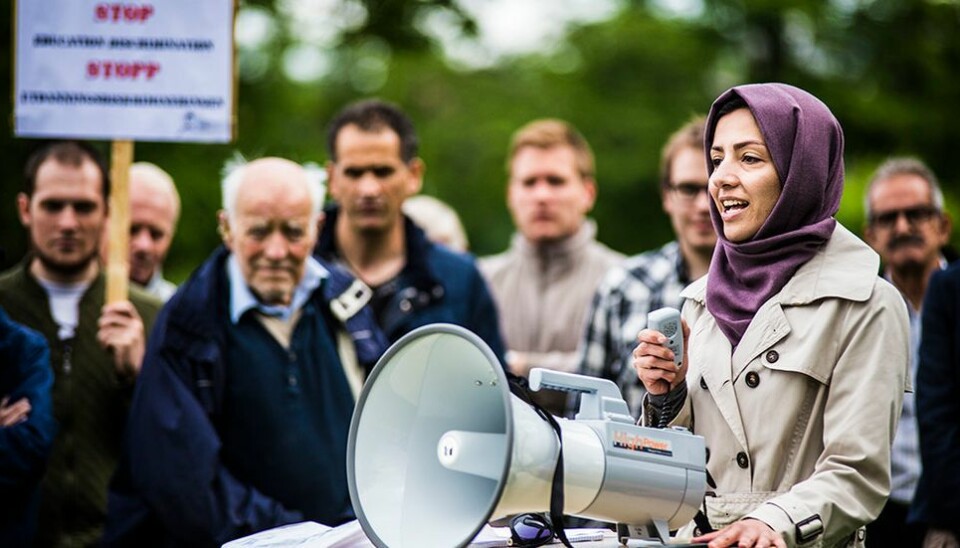Norway’s treatment of Iranian students:
Stricter than MIT, ETH and Cambridge
Norway’s policy of expelling Iranian PhD candidates differs significantly from the guidelines MIT and other world-leading universities are subject to.
Hamideh Kaffash har vært svært aktiv i kampanjen for å stanse det mange mener er diskriminering av iranere i Norge. Her er hun på talerstolen under en protestmarkering på Gløshaugen.
KRISTOFFER FURBERG
Kimberly Allen, director of Media Relations at MIT, simply states that the MIT campus is fully dedicated to fundamental research and that MIT has a policy of open access to research. This policy is consistent with US export control regulations, since Iranian citizens aiming to work in the energy or nuclear sector in Iran will be denied visa in the first place.
There are currently 9 000 Iranian students in the US. 35 of them are graduate students at MIT.
Background check
Universitetsavisa has asked five of the ten universities ranging first in most listings of the world’s leading technological universities. Four of them have answered. The responses from MIT in Boston, ETH Zürich, Imperial College in London and the University of Cambridge reveal a much more open policy towards Iranian students and researchers than the one Norway pursues.
UK, like the US, has procedures preceding admission at the universities. The so called ATAS clearance was introduced in 2007 and is administered by the Foreign and Commonwealth Office.
“ATAS is basically a background check. It is required of students from all nationalities wishing to enter certain areas in science, engineering and technology, and seeks to prevent them from accessing information or technology which could be used to develop weapons of mass destruction. Hence this is not for the university to decide,” says Tim Holt, Head of Communications at the University of Cambridge. Cambridge has 24 post graduates from Iran.
Imperial College in London provide a similar answer:
“The College does not restrict applications from students from any nationality. As with all UK universities, certain courses require the ATAS certificate before applying,” a spokesperson says.
Not an issue
Head of Media Relations at ETH Zürich, Roman Klingler, says the university doesn’t have any particular policy on candidates from Iran. People are admitted on the basis of their academic qualifications.
However, Switzerland adheres to sanctions imposed by the UN and other organizations they are part of. ETH does have a nuclear program, on the other hand no Iranians are enrolled.
There are 68 Iranian PhD candidates at ETH. Most of them work in the Department of Civil, Environmental and Geomatic Engineering, the Department of Mechanical and Process Engineering or in the Department of Computer Science. The possible security risk linked to these candidates has not been an issue at ETH or between ETH and Swiss authorities, says Klingler.
Seemingly grotesque
Norway conduct a more severe policy on these matters. Narjes Jafariesfad was first granted a visa on family reunion grounds. Nearly a year ago she joined her husband who works as a post doc on a three year program at NTNU, the Norwegian University of Science and Technology in Trondheim. After arriving, she was offered a position at a PhD candidate program on testing cementation of oil wells.
She applied for a work permit and started work. As other stories about evicted Iranians came to light, she called the immigration authorities to request about her case.
Jafariesfad was horrified by what she learned: she was told not only to leave the program but also the country within June 20th.
All programs closed
Norway’s treatment of Iranians makes international headlines. BBC has covered it, as has Swedish Radio. The latter recently told the story of Mahtab Emami, who already lives in Norway with husband and children. She was denied a place at Buskerud University College outside Oslo. When she applied for a written explanation, she received the following:
“All our civil engineer programs are closed to Iranian citizens due to the sanctions against Iran and North Korea.”
The rector at Buskerud University College, Petter Aasen, explains:
“We have received instructions from the ministry to make sure there is no transfer of sensitive technology. Subsequently we have asked all faculties to go through their programs. What we have found, is that we don’t have the capacity to control all civil engineer students that walk in and out of the labs. The conclusion is that we have closed all civil engineering programs for Iranian citizens.”
Puts responsibility on universities
The Norwegian Ministry of Foreign Affairs confirms that this is official Norwegian policy. In a letter to Universitetsavisa, Acting Head of Communications Frode Overland Andersen at the MFA informs that the Ministry of Education and Research wrote a letter to all Norwegian universities and university colleges on March 14th this year underlining the responsibility of the universities themselves to avoid transfer of knowledge that might lead to the proliferation of weapons of mass destruction.
This illustrates a policy very different from the ones in the US and UK that free the universities of any such responsibilities: once the visas and ATAS certificates are in place, academic freedom rules.
“It is important to underline that the Norwegian rules are totally compatible with the restrictive measures of the European Union,” Overland Andersen concludes.
Only nuclear bars
Sweden is a member of the European Union. Chalmers University of Technology in Gothenburg allows Iranian students and researchers into all areas except nuclear engineering.
“Five years ago we had a public debate following a letter from the secret police to the universities. Since then, this hasn’t been a matter of public interest until Norway’s policy caught our attention,” says Lotta Rydberg. She heads the Unit of Admission and Degrees at Chalmers.
For years, Iranians were one of the largest foreign student communities at Chalmers, with more than 250 students admitted in 2009 alone. The numbers have fallen sharply over the last years, mainly due to the devaluation of the Iranian rial, making it much more expensive to enter universities with fees like Chalmers.
“Which is a great pity, since many of the young Iranians are extremely able,” laments Rydberg.
The reduction in Iranian applicants to Sweden helps explain the upturn in applications at NTNU the following years, since Norway has a different system funding PhD candidates.































